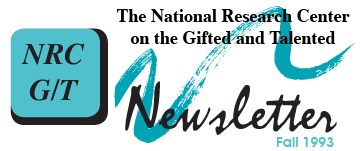
Robert J. Kirschenbaum
Evergreen Assessment Center
Ft. Lewis, WA
Most school districts restrict their selection of identification instruments to measures tapping academic aptitude, such as intelligence and achievement tests, grades, and teacher ratings/recommendations. The result, writes Richert (1985), is that certain groups of students are consistently underrepresented, including: “(a) underachieving, poor and minority gifted children who most need programs to develop their potential; (b) the creative and/or divergent thinkers whose abilities are not tested by standardized intelligence or achievement tests or grades; and (c) other groups including the learning disabled or handicapped gifted.” (p. 70)
A relatively new approach to assessing ability is to ask students to respond to a problem situation, provide assistance to help them improve their performance, and then measure various indices of improvement in their performance on similar problems. This approach is called dynamic assessment (Feuerstein, 1979). Different dynamic assessment models have been researched (Lidz, 1987), including assessment via assisted learning and transfer (Campione, 1989) and testing the limits (Carlson & Weidl, 1979). Campione (1989) explains that the common feature of these models is an emphasis on the individual’s potential for change.
Dynamic assessment is a diagnostic procedure that takes into account the context of the testing situation and the ability of the examinee to learn from experience. Lidz (1991) described it as
The importance of the unique format and focus of dynamic assessment is that the potential of students who come from disadvantaged populations or who are disabled in some way is directly assessed. Although a student’s disability or background may be taken into account in usual testing situations through a weighting formula or by comparing the student’s performance to others with similar characteristics, at best this offers an indirect means of assessing potential in these groups of students.
Dynamic assessment can be conducted in a formal, standardized manner or informally with individuals or small groups of students. A student can be assessed by recording the number of trials or amount of time needed to elicit correct performance, evaluating the quality of the response and the amount of intervention assistance needed to obtain a correct response, and the types of cognitive strategies used and extent to which the student understands the nature of the problem situation. This latter information is based on the student’s spontaneous or elicited comments.
The theoretical foundation for the development of the dynamic assessment approach comes from Vygotsky’s (1978) conception of the “zone of proximal development (ZPD).” From the Vygotskian perspective, potential is defined by the ZPD. Lidz (1991) writes that
Static assessment methods are those that measure student ability by presenting test tasks that the examinee must solve or answer by accessing previously acquired knowledge and skills without any assistance. Dynamic assessment methods are those that allow the examinee to benefit from prompting and active support from the examiner. In static assessment, the most important acts the examiner does are to administer the test and accurately record the number of test items answered correctly. In dynamic assessment, the examiner is more focused on discovering the type of intervention that improves the examinee’s performance on the test tasks.
Static and dynamic assessment methods should be considered complementary and not antagonistic means for estimating potential. Static assessment devices help us to understand how well a student has benefited from previous educational treatments, interventions, and experience in general. This information allows us to gauge a student’s background knowledge and skills. However, a student who has had an advantaged and enriched education could demonstrate a high level of achievement, yet have average ability. A student from a disadvantaged background showing a similar level of achievement may be demonstrating a higher level of ability.
It might be possible to train teachers to set up dynamic assessment situations in which certain types of performance are taught and then have them look for students who outperform their peers. Renzulli, Reis, and Smith (1981) applied the concept of dynamic assessment in developing the Revolving Door Identification Model (RDIM) to increase the number of creative-productive gifted students receiving gifted education. When a teacher of the gifted determines that a student in the “talent pool” has demonstrated a high level of domain-specific aptitude after receiving Type II enrichment (see Renzulli, 1977), a form of dynamic assessment is being used.
The decision to label a child gifted and talented is based on data that is interpreted against the backdrop of some value system. Those who most highly value academic giftedness, also called “schoolhouse giftedness” (Renzulli, 1986), will perceive only those students who excel on classroom assignments and achievement tests as being gifted. These are the students who are usually nominated by teachers to take the aptitude or intelligence tests on which the final labeling decision is based. Yet, recent research shows that when all students are allowed an opportunity to participate in an enrichment program, highly creative students perform as well as gifted students, even though they didn’t score high enough on aptitude tests to be selected for the gifted program (Kirschenbaum & Siegle, 1993).
Teachers will not nominate “creative-productive gifted” students (Renzulli, 1986) for a gifted program if the final selection decision is based solely on whether a student can meet a cut-off score criterion (Hunsaker, 1992). Hunsaker (1992) found that the school systems he studied relied on test scores as the “bottom line” in deciding who was gifted, although they avowed the use of multiple criteria. Teachers felt that they had limited influence on the identification process. Hunsaker suggests that a change in focus to looking at individuals rather than just test scores is necessary before teachers will feel they have some influence on who is selected for gifted programs. Dynamic assessment is a means by which teachers can document the ability of students to benefit from instructional interventions such as enrichment activities. This is particularly valuable if we want teachers to refer students who demonstrate creative thinking ability in their classes.